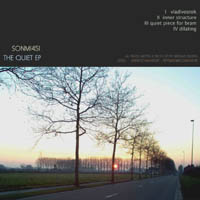Un affascinante e recente brano di Konstantinos Karathanasis, trentaduenne compositore greco emigrato negli USA.
Costruito intorno ad un’unica altezza (SI), questo pezzo, per sei strumenti e suoni elettronici, è come un singolo, ultra concentrato raggio di luce che penetra il vuoto, il silenzio, con gli strumenti che agiscono come delle lenti, dei prismi, che gradualmente modificano il colore del suono allargandolo alle note vicine e via via più lontane.
________________________
The following excerpt from an old Greek text of the 7th century AD encapsulates the central idea of the piece: ‘… And as all things come from the One, from the mediation of the One, so all things are born from this One by adaptation …’ There is one pitch (B), which as a single ultra-concentrated beam of light penetrates the vacuum, the silence. The instruments and the electronics act like lenses and prisms that slowly change the color of this single B and magnify it to the neighboring pitch areas. Since this process is gradual, like wine fermentation, special attention is given to various subtle changes, in the micro-intervals and their beatings, attacks and dynamics, colors and textures. Once the magnifications of the single pitch expand to its partials, the fermentation process is accelerated and new dimensions open up that at some point incorporate even chance.
The role of the electronics is to unify the instrumental fragments and thus to provide coherence through the piece. Although obscure at the beginning, progressively the computer becomes the seventh player in the ensemble, and after a certain point it develops in to an all-inclusive ocean, where the instruments swim, like exotic fish. The electronics are based in various real-time techniques in Max/MSP, mostly live phase vocoding and sampling, infinite decay reverbs, flangers, harmonizers, and granular synthesis.
Konstantinos Karathanasis – Obscuritas Luminosa, Lux Obscura (2005)
for flute, clarinet, viola, cello, piano, percussions, electronics


 Ho visitato
Ho visitato  Cosa ci fa Alfred Hitchcock sul
Cosa ci fa Alfred Hitchcock sul  Ecco come si faceva musica elettronica qualche anno fa. Visto che qualcuno di voi ci è nato nel 1982, magari così si fa un’idea.
Ecco come si faceva musica elettronica qualche anno fa. Visto che qualcuno di voi ci è nato nel 1982, magari così si fa un’idea. Post-conceptual digital artist and theoretician Joseph Nechvatal pushes his experimental investigations into the blending of computational virtual spaces and the corporeal world into the sonic register.
Post-conceptual digital artist and theoretician Joseph Nechvatal pushes his experimental investigations into the blending of computational virtual spaces and the corporeal world into the sonic register.